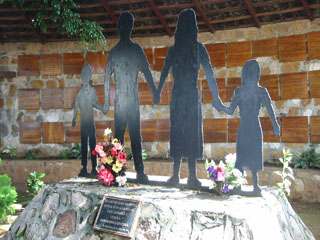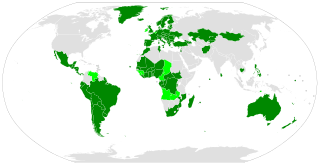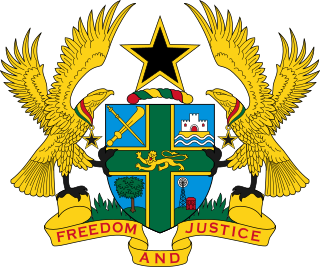International human rights instruments are the treaties and other international texts that serve as legal sources for international human rights law and the protection of human rights in general. There are many varying types, but most can be classified into two broad categories: declarations, adopted by bodies such as the United Nations General Assembly, which are by nature declaratory, so not legally-binding although they may be politically authoritative and very well-respected soft law;, and often express guiding principles; and conventions that are multi-party treaties that are designed to become legally binding, usually include prescriptive and very specific language, and usually are concluded by a long procedure that frequently requires ratification by each states' legislature. Lesser known are some "recommendations" which are similar to conventions in being multilaterally agreed, yet cannot be ratified, and serve to set common standards. There may also be administrative guidelines that are agreed multilaterally by states, as well as the statutes of tribunals or other institutions. A specific prescription or principle from any of these various international instruments can, over time, attain the status of customary international law whether it is specifically accepted by a state or not, just because it is well-recognized and followed over a sufficiently long time.

The International Covenant on Civil and Political Rights (ICCPR) is a multilateral treaty that commits states parties to respect the civil and political rights of individuals, including the right to life, freedom of religion, freedom of speech, freedom of assembly, electoral rights and rights to due process and a fair trial. It was adopted by United Nations General Assembly Resolution 2200A (XXI) on 16 December 1966 and entered into force 23 March 1976 after its thirty-fifth ratification or accession. As of June 2022, the Covenant has 173 parties and six more signatories without ratification, most notably the People's Republic of China and Cuba; North Korea is the only state that has tried to withdraw.
International human rights law (IHRL) is the body of international law designed to promote human rights on social, regional, and domestic levels. As a form of international law, international human rights law are primarily made up of treaties, agreements between sovereign states intended to have binding legal effect between the parties that have agreed to them; and customary international law. Other international human rights instruments, while not legally binding, contribute to the implementation, understanding and development of international human rights law and have been recognized as a source of political obligation.

The Convention against Torture and Other Cruel, Inhuman or Degrading Treatment or Punishment is an international human rights treaty, under the review of the United Nations, that aims to prevent torture and other acts of cruel, inhuman, or degrading treatment or punishment around the world.
Cruel and unusual punishment is a phrase in common law describing punishment that is considered unacceptable due to the suffering, pain, or humiliation it inflicts on the person subjected to the sanction. The precise definition varies by jurisdiction, but typically includes punishments that are arbitrary, unnecessary, overly severe compared to the crime, or not generally accepted in society.

The American Convention on Human Rights, also known as the Pact of San José, is an international human rights instrument. It was adopted by many countries in the Western Hemisphere in San José, Costa Rica, on 22 November 1969. It came into force after the eleventh instrument of ratification was deposited on 18 July 1978.
The Manual on Effective Investigation and Documentation of Torture and Other Cruel, Inhuman or Degrading Treatment or Punishment, commonly known as the Istanbul Protocol, is the first set of international guidelines for documentation of torture and its consequences. It became an official United Nations document in 1999.
Psychological torture or mental torture is a type of torture that relies primarily on psychological effects, and only secondarily on any physical harm inflicted. Although not all psychological torture involves the use of physical violence, there is a continuum between psychological torture and physical torture. The two are often used in conjunction with one another and often overlap in practice, with the fear and pain induced by physical torture often resulting in long-term psychological effects, and many forms of psychological torture involving some form of pain or coercion.

Human rights are largely respected in Switzerland, one of Europe's oldest democracies. Switzerland is often at or near the top in international rankings of civil liberties and political rights observance. Switzerland places human rights at the core of the nation's value system, as represented in its Federal Constitution. As described in its FDFA's Foreign Policy Strategy 2016-2019, the promotion of peace, mutual respect, equality and non-discrimination are central to the country's foreign relations.
The European Committee for the Prevention of Torture and Inhuman or Degrading Treatment or Punishment or shortly Committee for the Prevention of Torture (CPT) is the anti-torture committee of the Council of Europe. Founded to enforce the European Convention for the Prevention of Torture and Inhuman or Degrading Treatment or Punishment, the CPT visits places of imprisonment in signatory countries and issues reports on violations of the convention.

The Optional Protocol to the Convention against Torture and other Cruel, Inhuman or Degrading Treatment or Punishment is a treaty that supplements to the 1984 United Nations Convention Against Torture. It establishes an international inspection system for places of detention modeled on the system that has existed in Europe since 1987.
The European Convention for the Prevention of Torture and Inhuman or Degrading Treatment or Punishment was adopted by the member states of the Council of Europe, meeting at Strasbourg on 26 November 1987. After the European Convention on Human Rights, the Convention for the Prevention of Torture is widely regarded as being one of the most important of the Council of Europe's treaties. The Convention marks a fresh and preventive approach in handling human rights violations. It was subsequently amended by two Protocols. Additionally, the Committee for the Prevention of Torture was established to comply with the provisions of the convention. This body is enabled to visit any place within the jurisdiction of the states' parties where people are deprived of their liberty in line with the articles of the convention.
Article 3 of the European Convention on Human Rights prohibits torture, and "inhuman or degrading treatment or punishment".
Article 3 – Prohibition of torture No one shall be subjected to torture or to inhuman or degrading treatment or punishment.
The Association for the Prevention of Torture (APT) is an international non-governmental organization focused on the prevention of torture and other acts of cruel, inhuman, or degrading treatment. The organization was founded in 1977 by Jean-Jacques Gautier under the name Swiss Committee against Torture.

Human rights are "rights and freedoms to which all humans are entitled". Proponents of the concept usually assert that everyone is endowed with certain entitlements merely by reason of being human.
Papua New Guinea (PNG) has a population of 6.8 million, nearly half of which is under 18 years of age. Public trust in the justice system has been eroded, and the country’s significant crime problem exacerbated, by brutal responses from police against those they suspect of having committed offences, and the routine violence, abuse and rape carried out by police against persons, including children, within their custody. Many incidents are cases of opportunistic abuses of power by police instead of their following official processes. While a raft of measures have been assembled in order to improve conditions and processes for youths within the justice system, their success has been hampered by a severe lack of implementation, insufficient resources, and failure to impose appropriate penalties on authorities for failure to adhere to their provisions.
The Republic of Uruguay is located in South America, between Argentina, Brazil and the South Atlantic Ocean, with a population of 3,332,972. Uruguay gained independence and sovereignty from Spain in 1828 and has full control over its internal and external affairs. From 1973-85 Uruguay was governed by a civil-military dictatorship which committed numerous human rights abuses.
Cruel, inhuman or degrading treatment (CIDT) is treatment of persons which is contrary to human rights or dignity, but is not classified as torture. It is forbidden by the Universal Declaration of Human Rights, Article 3 of the European Convention on Human Rights, the United Nations Convention against Torture and the International Covenant on Civil and Political Rights. Although the distinction between torture and CIDT is maintained from a legal point of view, medical and psychological studies have found that it does not exist from the psychological point of view, and people subjected to CIDT will experience the same consequences as survivors of torture. Based on this research, some practitioners have recommended abolishing the distinction.
The prohibition of torture is a peremptory norm in public international law—meaning that it is forbidden under all circumstances—as well as being forbidden by international treaties such as the United Nations Convention Against Torture.
Torture is generally defined as deliberately inflicting "severe pain or suffering" on a prisoner, but exactly what this means in practice is disputed.






